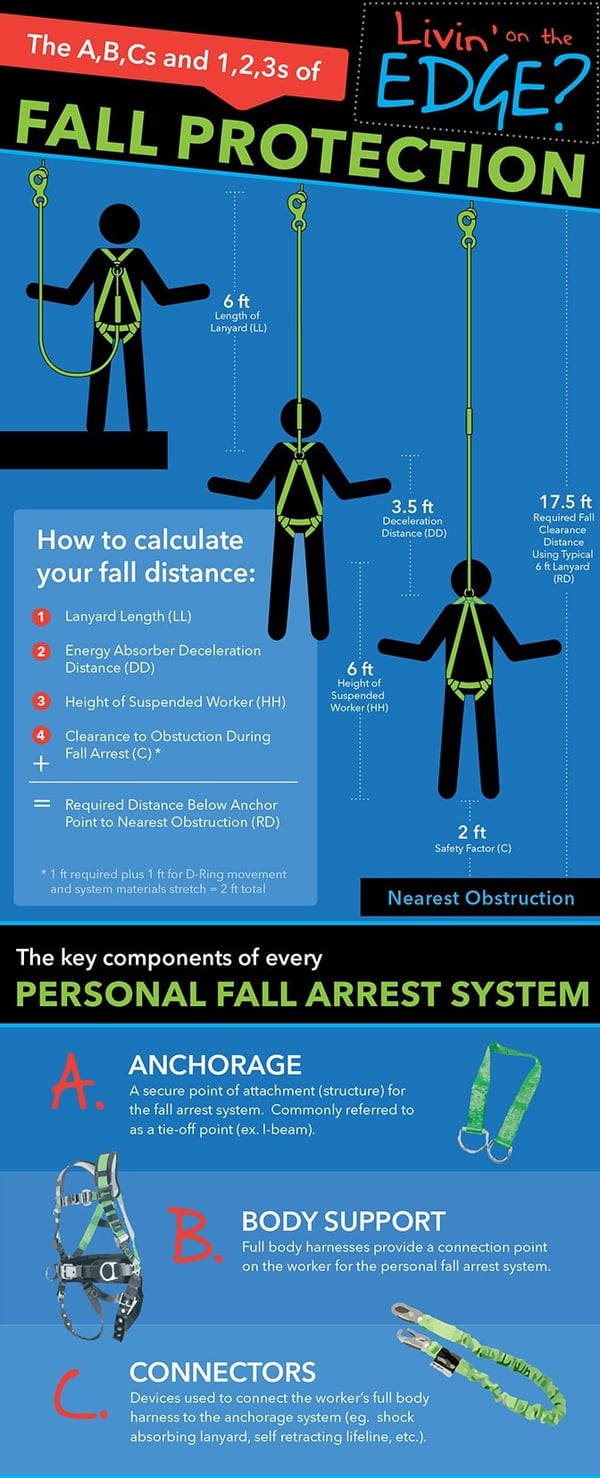SRL’s vs. Lanyards: Choosing the Correct PPE for Your Fall Protection Application
If you are a frequent visitor to our Tech Talk area, you have read articles discussing the ABCD’s of fall protection. This easy-to-remember acronym (anchorage, body harness, connecting device, and descent) is reasonably straightforward, but some folks get confused over connecting devices. Workers create connections between their body harness and the anchorage point using two distinct methodologies: (i) Self-Retracting Lifelines and (ii) Shock Absorbing Lanyards. Both of these options have pros and cons, and clients often ask which approach is better. If you find yourself wondering which option is better, the answer depends on budget and, more importantly, the specifics of the application.
Budget is the simplest part of the equation. As PPE (personal protective equipment) goes, lanyards are less expensive than SRL’s, so when cost is the primary concern, lanyards often get the nod. That said, lanyards are not always the best option due to a concept called total fall clearance distance. For our purposes, we will define this concept as the distance a worker falls before coming into contact with the ground or equipment below the work area.
Budget notwithstanding, an SRL is often the better option because it requires shorter fall clearance distances. During a fall, the braking mechanism inside the SRL begins to engage within 8 to 9 inches, decelerating the drop. Within 3-4 feet, a falling worker is at a complete stop.
3.5 feet of deceleration + 2 foot OSHA Safety Margin + 6 Foot Worker Height = 12.5 feet total fall distance clearance required
By comparison, a typical six-foot lanyard requires almost 18 feet of total fall clearance distance. Unlike the SRL, which begins slowing a fall within a foot, a worker will drop the entire length of the lanyard before the shock absorbing pack engages – and it is common for lanyards to extend an additional 3-4 feet before the fall is even arrested. When you take into consideration the height of the body harness D-ring on your typical worker (just shy of six feet) and the OSHA required safety margin (2 feet for SRL’s and lanyards), it is easy to see why the total fall clearance distance for a lanyard is approximately 18 feet.
6 foot Lanyard + 3.5 feet of deceleration + 6 foot height of worker + 2 foot OSHA Safety Margin = 17.5 feet total fall distance clearance required
Although shorter fall clearance distances is an obvious advantage, there are other reasons why we tend to recommend SRL’s over lanyards. Assuming a fixed anchor point, a worker has a six-foot radius when using a lanyard. Moving beyond this relatively small work area requires connecting to a new anchor point. With a retractable lifeline, the worker is free to cover a larger work radius that is limited only by the lifeline length and the braking action that occurs when making sudden movements.
In addition to worker mobility, we also need to consider how the work area’s fall clearance distance may change throughout the day. For applications where the fall clearance distance remains at a constant, safe level (e.g., factory applications), use of a lanyard makes sense. For a contractor welding structural steel on a jobsite, the fall clearance distance can change hourly. At the start of the day, a contractor working on the third story of a new building could have the 18.5 feet required for safe lanyard use. This same contractor might have a finished steel deck on the second floor by lunch. By mid-day, our hypothetical contractor’s lanyard will not arrest the fall before he or she strikes the new, second floor decking below. For all of these reasons, we give the nod to SRL’s over lanyards.
Remember, saving money on PPE is pointless if the equipment will not arrest a fall before the worker hits the ground. It is tempting to shop fall protection PPE on price, however, you need to carefully consider cost and APPLICATION when making decisions about fall protection PPE.
If you have questions about selecting the proper PPE for your fall protection application, or need to order Self-Retracting Lifelines or Lanyards, contact the safety experts at Diversified Fall Protection for further assistance.
Schedule an assessment with Diversified Fall Protection
Contact Us to request a fall safety review

b-1.jpg?width=1368&height=1340&name=Rail%20(175)b-1.jpg)


